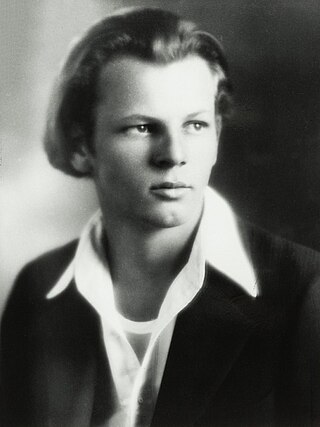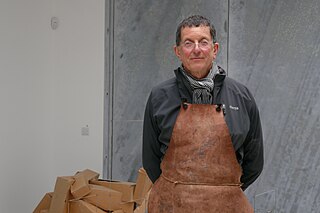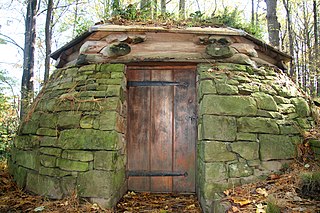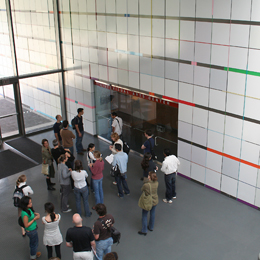
Paul Jackson Pollock was an American painter. A major figure in the abstract expressionist movement, Pollock was widely noticed for his "drip technique" of pouring or splashing liquid household paint onto a horizontal surface, enabling him to view and paint his canvases from all angles. It was called all-over painting and action painting, since he covered the entire canvas and used the force of his whole body to paint, often in a frenetic dancing style. This extreme form of abstraction divided the critics: some praised the immediacy of the creation, while others derided the random effects.

Land art, variously known as Earth art, environmental art, and Earthworks, is an art movement that emerged in the 1960s and 1970s, largely associated with Great Britain and the United States but that also includes examples from many countries. As a trend, "land art" expanded boundaries of art by the materials used and the siting of the works. The materials used were often the materials of the Earth, including the soil, rocks, vegetation, and water found on-site, and the sites of the works were often distant from population centers. Though sometimes fairly inaccessible, photo documentation was commonly brought back to the urban art gallery.

Sir Antony Mark David Gormley is a British sculptor. His works include the Angel of the North, a public sculpture in Gateshead in the north of England, commissioned in 1994 and erected in February 1998; Another Place on Crosby Beach near Liverpool; and Event Horizon, a multipart site installation which premiered in London in 2007, then subsequently in Madison Square in New York City (2010), São Paulo, Brazil (2012), and Hong Kong (2015–16).
Paul Jenkins was an American abstract expressionist painter.

Cloud Chamber for the Trees and Sky is a site specific outdoor artwork by Chris Drury. It was commissioned by North Carolina Museum of Art in 2003 made possible by the Robert F. Phifer Bequest and located in the 146 acre museum park adjacent to the museum known as the Ann and Jim Goodnight Museum Park at state capital Raleigh. The artwork is situated in woodland with other large sculptures and is accessed along a woodland path.
Cape Farewell is an artist led organisation that works to create an urgent cultural response to climate change. Launched by David Buckland in 2001 with a series of ground-breaking artist and scientist manned expeditions to the Arctic, Cape Farewell has become an international not-for-profit programme based at the University of the Arts London: Chelsea.
Richard Humann is a New York City-based American neo-conceptual artist. His art delves deep into concept and ideas, and he uses a multitude of materials to create his installations, sculptures, videos, and sound projects. Richard Humann's influences are as broad ranging as from Donald Judd, and Nam June Paik, to Jonathan Borofsky. His artwork bears conceptual similarities and to that of Joseph Kosuth, Sol LeWitt, Lawrence Weiner, Edward Ruscha, and Robert Morris.

Established in 1950, the List Visual Arts Center (LVAC) is the contemporary art museum of the Massachusetts Institute of Technology. It is known for temporary exhibitions in its galleries located in the MIT Media Lab building, as well as its administration of the permanent art collection distributed throughout the university campus, faculty offices, and student housing.
Squeak Carnwath is an American contemporary painter and arts educator. She is a professor emerita of art at the University of California, Berkeley. She has a studio in Oakland, California, where she has lived and worked since 1970.

Tanya Preminger, is an artist working in various media: environmental art, site-specific art, ephemeral art, sculpture, installation and photography. She is mostly known for her land art projects and large-scale stone sculptures.
Strijdom van der Merwe is a South African land artist who uses materials he finds on site to create his artworks. His materials include sand, water, wood, rocks and stone. By shaping these elements into geometric forms he juxtaposes the contrast between artwork and environment, growth and destruction. Van Der Merwe's works are often very 'free' in the sense that he is able to respond to nature, but within the context of ' nature having a bigger impact on you, than you on nature'. A site, and the materials it offers, will reveal itself to you as the artist as you walk – be it in a forest, or along a beach, or in the Karoo. Only then will ideas and working methods start developing. It's a process of working with the natural material you find on site. Nothing is planned ahead – it's all improvised as you go along.

Charles Ross is an American contemporary artist known for work centered on natural light, time and planetary motion. His practice spans several art modalities and includes large-scale prism and solar spectrum installations, "solar burns" created by focusing sunlight through lenses, paintings made with dynamite and powdered pigment, and Star Axis, an earthwork built to observe the stars. Ross emerged in the mid-1960s at the advent of minimalism, and is considered a forerunner of "prism art"—a sub-tradition within that movement—as well as one of the major figures of land art. His work employs geometry, seriality, refined forms and surfaces, and scientific concepts in order to reveal optical, astronomical and perceptual phenomena. Artforum critic Dan Beachy-Quick wrote that "math as a manifestation of fundamental cosmic laws—elegance, order, beauty—is a principle undergirding Ross’s work … [he] becomes a maker-medium of a kind, constructing various methods for sun and star to create the art itself."

Miya Ando is an American visual artist recognized for her paintings, sculptures, and installation artworks that address concepts of temporality, interdependence, and impermanence. Ando's artworks have been exhibited in museums, galleries, and public spaces worldwide.
James Parsons Dalglish is an American abstract painter. He lives and works in New York City.
Gail Wight is an American new media artist and professor, whose work fuses art with biology, neurology, and technology. Popular media Wight uses to create art include, drawing and painting, electronic sculpture, interactive sculpture, video and living mediums. Since 2003, Wight has taught at Stanford University in the Department of Art.

Maureen Robin Lander is a New Zealand weaver, multimedia installation artist and academic. Lander is of Ngāpuhi and Pākehā descent and is a well-respected and significant artist who since 1986 has exhibited, photographed, written and taught Māori art. She continues to produce and exhibit work as well as attend residencies and symposia both nationally and internationally.
Zarouhie Abdalian is an American artist of Armenian descent, known for site-specific sculptures and installations.

Lindy Lee is an Australian painter and sculptor of Chinese heritage, whose work blends the cultures of Australia and her ancestral China and explores her Buddhist faith. She has exhibited widely, and is particularly known for her large works of public art, such as several iterations of The Life of Stars at various locations in China and on the forecourt of the Art Gallery of South Australia, and The Garden of Cloud and Stone in Sydney's Chinatown district.
Tarnanthi is a Festival of Contemporary Aboriginal and Torres Strait Islander Art held in Adelaide, South Australia, annually. Presented by the Art Gallery of South Australia (AGSA) in association with the South Australian Government and BHP. It is curated by Nici Cumpston.

Juliana Cerqueira Leite is a Brazilian sculptor based in New York, known for creating large-scale works that explores the physical presence of the human body. She is considered to push the boundaries of sculpture.




















